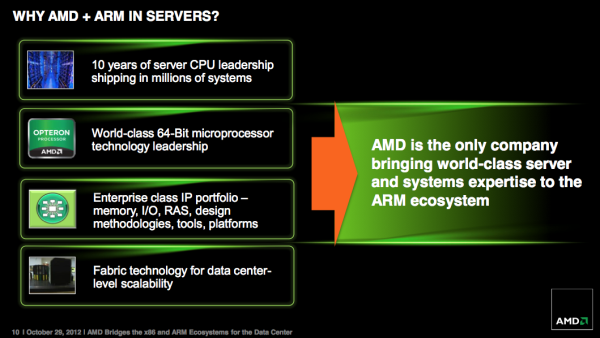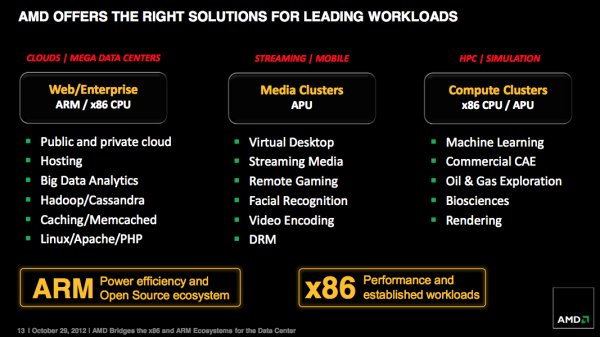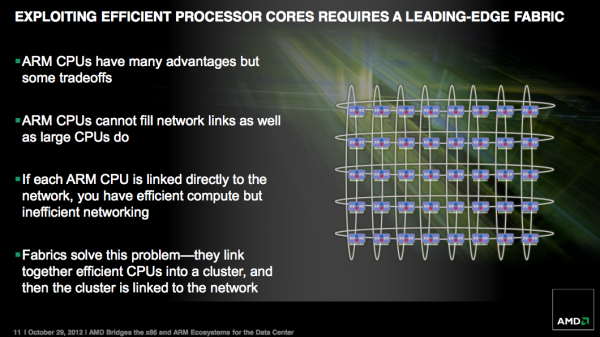AMD Will Build 64-bit ARM based Opteron CPUs for Servers, Production in 2014
by Anand Lal Shimpi on October 29, 2012 4:48 PM EST- Posted in
- Cloud Computing
- CPUs
- IT Computing
- AMD
- Arm
- Opteron
Last year AMD officially became an ARM licensee, although the deal wasn't publicized at the time. Fast forward to June 2012 and we saw the first fruits of that deal: AMD announced it would integrate ARM's Cortex A5 core into its 2013 APUs to enable TrustZone support.
Today comes a much bigger announcement: AMD will be building Opteron processors based on a 64-bit ARM architecture. There are no product announcements today, but the 64-bit ARM Opterons will go into production in 2014. Today's announcement is about a processor license, not an ARM architecture license - in other words, AMD will integrate an ARM designed 64-bit core for this new Opteron. Update: AMD will integrate ARM's new Cortex-A50 series of 64-bit ARMv8 CPU cores.
The only other detail we know is that these ARM based Opterons will embed SeaMicro's Freedom Fabric, presumably on-die.
AMD offering ARM based Opterons is really to target the microserver market. As for why AMD isn't using Jaguar for these parts, it's likely that by going with ARM it can lower the development time and cost to get into this market. The danger here is the total microserver market is expected to be around 10% of the overall server market, but that includes x86 + ARM. With x86 as the default incumbent, it's going to be an uphill battle for AMD/ARM to carve out a significant portion of that market.
AMD was quick to mention that despite today's announcement, it will continue to build x86 CPUs and APUs for client and server markets.
Overall the move sounds a lot like AMD trying to move quickly to capitalize on a new market. It's unclear just how big the ARM based server market will be, but AMD seems to hope that it'll be on the forefront of that revolution - should it happen. Embracing ARM also further aligns AMD with one of Intel's most threatening sources of competition at this point. The question is whether or not AMD is doing itself more harm than good by working to devalue x86 in the server space. I suspect it'll be years before we know the real impact of AMD's move here.
The other major takeaway is that AMD is looking to find lower cost ways of bringing competitive platforms to market. I do think that a Jaguar based Opteron would likely be the best route for AMD, but it would also likely require a bit more effort than integrating an ARM core.
Obviously competition will be more prevalent in the ARM server space, but here is where AMD hopes its brand and position in the market will be able to give it an advantage. AMD will also be relying heavily on the SeaMicro Freedom Fabric for giving its ARM based Opterons a leg up on the competition. This is one time where I really wish AMD hadn't spun off its fabs.













32 Comments
View All Comments
nofumble62 - Tuesday, October 30, 2012 - link
It does not have PCIe gen 3. Why it is called high speed?Jaybus - Wednesday, October 31, 2012 - link
No. Intel already tried something similar with Larrabee.iwod - Monday, October 29, 2012 - link
We now know ARM's memory controller is its weakest area, do the license means AMD will be using the same controller for server applications? Or would they design something different.I think there are increasing number roles in Web Server market where there is Low CPU usage with High Memory usage such as caching servers. Which is a perfect fit for ARM typed CPU.
And it is interesting that it was AMD who states they want x86 from top to bottom. And x86 will shrinks and grows. Then they came up with x64. Intel decided the other way and wanted IA-64 aka Itanium and ARM Xscale CPU for the low end. It was x64 that force Intel to rethink and license it, then sold Xscale and now literally gave up on Itanium. Now they swap position and It is Intel who thinks x86 should be used from top to bottom and AMD decided to use ARM, how time changes.
booleanalgebra - Monday, October 29, 2012 - link
Not sure about AMD but this does lend credibility to the minions of ARM server guys like AppliedMicro and Calxeda who have been at it for many years already.AMD was one of the two (main) members of the exclusive x86 club. For them to abandon that exclusivity and go with standard ARM cores is a testament in itself. But giving up that exclusivity also means they need to compete with the likes of AppliedMicro who have a head start on them. There will also be other ARM server players coming out of the woodwork so AMD will have to count on better execution - not their strong forte.
andrewaggb - Tuesday, October 30, 2012 - link
AMD isn't competing well in any market right now that I can see, other than bargain laptops and desktops. Their graphics lead (as far as perf/watt/$$ is lost as nvidia really turned it around).By all indications haswell's integrated graphics may catch up (at least in benchmarks) to amd's integrated graphics.
They're almost hopelessly behind intel in single threaded performance, they have no smartphone wins, no windows 8 tablet wins (that I know of), almost no ultrabook-a-likes,
I don't know that switching to ARM will help them either. Sure you can use somebody else's cpu designs, but it's not a competitive advantage. You're likely using the same foundry as everybody else as well. Your graphics are good, but not especially low power, and you've conceded the high end to intel.
I don't want AMD to go away, but entering a very competitive market that Texas Instruments just pulled out of seems risky to me. Unless you're sure you can one up qualcomm, nvidia and apple, what's the point? I doubt they'll be one-upping anybody using stock core designs.
Hopefully I'm wrong.
dvinnen - Tuesday, October 30, 2012 - link
I would feel better about this venture if they were designing their own chips. I can imagine an ARM processor with a AMD memory controller and HyperTransport links built in could be a cool and viable product.Not seeing that with just rebranding an ARM core as an Opteron
rrohbeck - Tuesday, October 30, 2012 - link
Once they make their own designs, I can see interesting options:An ARM APU with a Radeon GPU for graphics performance and GPGPU (HSA)
An ARM CPU that combines an ARM instruction decoder with a high performance back end
An x86 Opteron with a low end GPU and built-in ARM core as a IPMI BMC
And my favorite: A CPU that supports both x86 and ARM instructions. "Just" add an ARM instruction decoder to an Opteron.
hrga - Tuesday, October 30, 2012 - link
I like this part of IPMI BMC but that doesn't seems viable as this kind of specific CPu would still require Serial Port Interface + Super I/O + switchable logic and all that doesn't work on low voltages 1.2-1.4V as CPU ... some IPMI substitute could be blueprinted this wayMy favorite would be CPU that doesn't "just support both instruction set" [ARMv8 and x86-64] but something that i could use w/o OS reboot as power sawing feature. But this even crappily new Win8 doesn't support yet (and probably wont!).
So at least they could in new desktop socket that will be brought for HSA, probably with Excavator @20nm, along integrate two "el cheapo" Jaguar cores to do the similar feature and yet every OS could do that w/o any issue as both share same x86-64 architecture.
Any good market thing with ARMv8 is if they go same way as nvidia announced their Tesla line should go. To integrate few ARMv8 cores directly onto GP-GPU which then could boot directly w/o need of any traditional x86-64/IA64 CPU.
nofumble62 - Tuesday, October 30, 2012 - link
Dirk got fired because he hold on to x86 too long and let Nvidia jumped on ARM.I guess that has always been the board intention. So they fired all the people don't go along with them.
Does AMD have a chance with ARM? yes.
Do they have enough time? No. They will run out of cash way before the first chip is launched.
Metaluna - Tuesday, October 30, 2012 - link
As I see it, Intel is really the last of the companies that can sell CPUs as their defining product and profit center. ARM is a race to the bottom profit-wise. You can differentiate a little bit with custom architectures, but ARM cores are pretty much a commodity. That's not a bad thing necessarily, but it means that CPUs become just a small part of an overall product line. Nobody thinks of Qualcomm, Broadcom, Samsung, Apple, etc. as a processor company, nor is anyone paying a premium for ARM-based processors.What I'm saying is, if AMD is going to go this route, it needs to become a much more diversified company than it currently is.